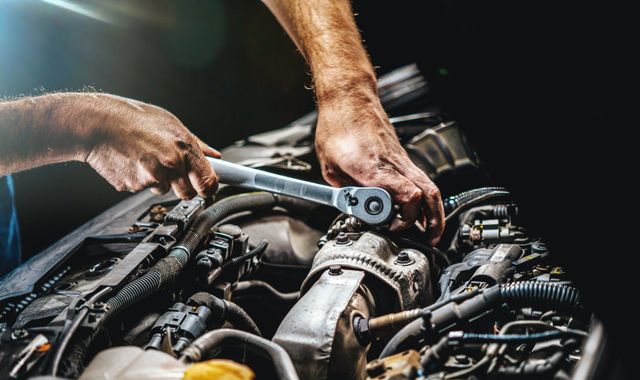All Categories
Featured
The check engine light (CEL) is among one of the most identifiable control panel indicators, yet it commonly strikes concern or confusion in motorists. While it's very easy to stress when the light brightens, recognizing its objective and understanding exactly how to respond can assist you take the ideal steps to resolve potential concerns. This beginner's overview breaks down what the check engine light means, usual reasons, and just how to handle it.
What Is the Examine Engine Light? The check engine light becomes part of your automobile's onboard diagnostics (OBD) system, designed to check engine efficiency and emissions. When the system spots a trouble, the CEL brightens to inform you. The light might appear as a constant radiance or a blinking signal, each bring different degrees of urgency.
Strong Light: Suggests a less prompt concern, but it still requires focus. Flashing Light: Signals a much more major trouble, such as a misfire, which might harm your engine or catalytic converter if overlooked. Usual Root Causes Of the Examine Engine Light. The CEL can activate for a range of factors, ranging from minor issues to significant repair services. Below are a few of the most usual perpetrators:
Loosened or Faulty Gas Cap:
A loosened gas cap can cause fuel vapors to run away, setting off the CEL. This is one of the most convenient and least pricey solutions-- replace the cap or tighten. Faulty Oxygen Sensing Unit:
![]()
The oxygen sensor keeps track of the air-to-fuel proportion in your engine. A defective sensing unit can reduce gas effectiveness and rise emissions. Malfunctioning Glow Plugs or Ignition Coils:
Worn-out stimulate plugs or coils can cause engine misfires. Routine tune-ups help stop this problem. Catalytic Converter Issues:
The catalytic converter decreases unsafe emissions. Issues with this part can be pricey and usually result from overlooking other concerns. Mass Air Movement Sensor Troubles:
The mass airflow (MAF) sensing unit gauges the air going into the engine. A unclean or damaged MAF sensing unit can influence performance and fuel economic climate. What to Do When the Check Engine Light Begins. Don't Panic:
If the light is stable, it's risk-free to drive to a service center. If it's blinking, lower rate and prevent tough acceleration; pull over and seek instant support. Examine for Obvious Issues:
Tighten the gas cap, as this is a basic and typical fix. Search for indications of significant difficulty, such as smoke or unusual engine noises. Utilize an OBD-II Scanner:
An OBD-II scanner reads the problem codes kept in your auto's computer. Numerous automobile components shops provide totally free code scanning solutions. Consult a Professional Auto Mechanic:
![]()
If you can't fix the concern on your own, take your auto to a relied on auto mechanic. Supply the problem code for a quicker and more precise medical diagnosis. Preventative Steps. Normal maintenance is vital to staying clear of CEL concerns. Right here's just how to remain in advance:
Set Up Routine Tune-Ups: Change evaluate and stimulate plugs ignition elements consistently. Maintain Fluids Rounded Off: Ensure appropriate levels of oil, coolant, and various other liquids. Usage Quality Fuel: Poor-quality fuel can lead to sensing unit and exhausts concerns. Conclusion. The check engine light does not need to give stress. By comprehending its objective and recognizing how to address it, you can maintain your cars and truck running smoothly and stay clear of costly repairs. Treat the CEL as a handy tool rather than an annoyance, and it will assist you to preserving your lorry's wellness successfully.
What Is the Examine Engine Light? The check engine light becomes part of your automobile's onboard diagnostics (OBD) system, designed to check engine efficiency and emissions. When the system spots a trouble, the CEL brightens to inform you. The light might appear as a constant radiance or a blinking signal, each bring different degrees of urgency.
Strong Light: Suggests a less prompt concern, but it still requires focus. Flashing Light: Signals a much more major trouble, such as a misfire, which might harm your engine or catalytic converter if overlooked. Usual Root Causes Of the Examine Engine Light. The CEL can activate for a range of factors, ranging from minor issues to significant repair services. Below are a few of the most usual perpetrators:
Loosened or Faulty Gas Cap:
A loosened gas cap can cause fuel vapors to run away, setting off the CEL. This is one of the most convenient and least pricey solutions-- replace the cap or tighten. Faulty Oxygen Sensing Unit:

The oxygen sensor keeps track of the air-to-fuel proportion in your engine. A defective sensing unit can reduce gas effectiveness and rise emissions. Malfunctioning Glow Plugs or Ignition Coils:
Worn-out stimulate plugs or coils can cause engine misfires. Routine tune-ups help stop this problem. Catalytic Converter Issues:
The catalytic converter decreases unsafe emissions. Issues with this part can be pricey and usually result from overlooking other concerns. Mass Air Movement Sensor Troubles:
The mass airflow (MAF) sensing unit gauges the air going into the engine. A unclean or damaged MAF sensing unit can influence performance and fuel economic climate. What to Do When the Check Engine Light Begins. Don't Panic:
If the light is stable, it's risk-free to drive to a service center. If it's blinking, lower rate and prevent tough acceleration; pull over and seek instant support. Examine for Obvious Issues:
Tighten the gas cap, as this is a basic and typical fix. Search for indications of significant difficulty, such as smoke or unusual engine noises. Utilize an OBD-II Scanner:
An OBD-II scanner reads the problem codes kept in your auto's computer. Numerous automobile components shops provide totally free code scanning solutions. Consult a Professional Auto Mechanic:

If you can't fix the concern on your own, take your auto to a relied on auto mechanic. Supply the problem code for a quicker and more precise medical diagnosis. Preventative Steps. Normal maintenance is vital to staying clear of CEL concerns. Right here's just how to remain in advance:
Set Up Routine Tune-Ups: Change evaluate and stimulate plugs ignition elements consistently. Maintain Fluids Rounded Off: Ensure appropriate levels of oil, coolant, and various other liquids. Usage Quality Fuel: Poor-quality fuel can lead to sensing unit and exhausts concerns. Conclusion. The check engine light does not need to give stress. By comprehending its objective and recognizing how to address it, you can maintain your cars and truck running smoothly and stay clear of costly repairs. Treat the CEL as a handy tool rather than an annoyance, and it will assist you to preserving your lorry's wellness successfully.
Latest Posts
Montclare Auto Repair: Your Local Specialist for Professional Engine & Brake Work
Published Apr 20, 25
2 min read
Discover the Certified Mechanics Behind Montclare Auto Repair - Here to Serve You
Published Apr 20, 25
2 min read
Making the Most of Your WyHy Monitoring Account
Published Apr 20, 25
1 min read
More
Latest Posts
Montclare Auto Repair: Your Local Specialist for Professional Engine & Brake Work
Published Apr 20, 25
2 min read
Discover the Certified Mechanics Behind Montclare Auto Repair - Here to Serve You
Published Apr 20, 25
2 min read
Making the Most of Your WyHy Monitoring Account
Published Apr 20, 25
1 min read